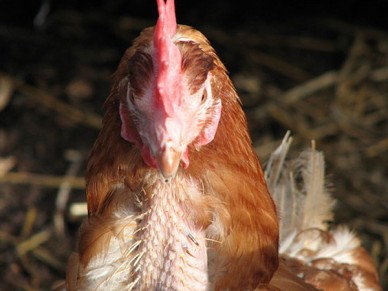Moulting and feather loss

Chickens need feathers to provide protection and insulation for the body and to make sure these vital assets stay in tip top condition chickens will shed their feathers annually – although it can occasionally happen more or less frequently – to replace old and worn feather.
For mature birds this usually occurs during late summer or early autumn so the process is complete before winter sets in. Young chickens will actually moult fully or partially several times before they reach maturity and it’s the last one, at about 20-22 weeks that completes the feather formation with the final stiff tail feathers that we are familiar with.
The first year tends to be a mini-moult affecting the head and neck area but the second year is a little more drastic with birds sometimes reaching almost ‘oven ready’ appearance. Hybrids tend to moult more often than pure breeds and may have a full or partial shed in the early spring as well as the Autumn. The whole process can take a month or two to be complete and starts at the neck, moves along the back, breast, wings and ends at the tail.
Sometimes dramatic total body moults occur where nearly all the feathers fall out. These full moult tends to happen mostly at night so when you open up the coop in the morning you will be greeted with a sight akin to an explosion in a duvet factory! It can be a shocking sight but be assured they will grow back.
After feathers are shed you will see the new quills poking through the flesh. These grow and open out into lovely the fresh new livery which will keep them warm and dry throughout the colder months.
During the moult your hens will invariably stop laying. It takes a lot of protein to manufacture new feathers so they tend to put all their efforts into this rather than egg production at this time. Once they are fully feathered again, the eggs should return as usual.
You need to ensure you provide a good quality layers meal that will provide all the correct nutrients required. Don’t give too many treats, these don’t really provide enough nutritional value. If your birds moult when the weather is particularly cold maize is good for providing inner body warmth and wheat is very good as a scatter feed in the afternoons. You might even consider a wheatgerm porridge made with warm water to keep their body temperature up overnight.
If they seem to be struggling with condition adding Poultry Spice to their layers meal or tonic to their water will help correct any mineral imbalance as they contain lots of minerals and will help the hens over the moulting process. Adding protein to the diet is also supposed to help hens over the moulting process so feeding live mealworms, hard boiled or scrambled eggs with the ground eggshell mixed in, oily fish or even cat food can help.
Other reason for moulting or feather loss
Feather pecking by other birds can be a reaction to overcrowding or as an attempt to intake more protein (again this is most prevalent at the time of moult) but if the pecking causes damage and blood or a wound appear then this can quickly draw the attention of other birds who will attack the damaged area and can cause quite a wound. Affect birds should be separated until they have had time to recover.
If you have hens running with cockerels, the attentions of the male, particularly if he takes a fancy to one hen in particular, can lead to a loss of feathers at the back of the neck and the area where he digs in his claws to ‘hang on’. If one hen in is getting too much attention and starts showing signs of physical damage it may be best to separate her from direct contact with the cockerel to allow her time to recover.
Finally, like us taking off a layer of clothing, during particularly hot weather chickens may shed feathers in an attempt to help them keep cool.
While these reasons for feather loss have no underlying health related issues and will more often than not remedy themselves in the course of time, or with the swift action of the keeper, there are times when feather loss is a result of disease or stress and this needs to be investigated and remedied with more urgency.
Disease and Stress

Ex-commercial hens will often display dramatic stress-related feather loss
Unhealthy birds or birds that are suffering from stress may also exhibit feather loss. Conditions such as overcrowding, excess heat or cold, disease, lack of, or too much competition for feed and water and even poor ventilation can result in feather loss or poor feather quality in your birds. If your birds are exhibiting feather loss that doesn’t appear to be related to the moult it may be a good time to examine any changes to your management routine or their environment that could be responsible for increased stress in your flock or a quick trip to the vet.
Main picture courtesy Lucky Hens Rescue
Poultry categories
Most recent Poultry articles
- Preventing egg laying problems in older hens with implants 15th March, 2017
- Integrating new chickens into an existing flock 15th May, 2016
- The nests in my heart – a personal view of ex-battery hens 22nd March, 2016
- Chicken FAQ: your most common chicken keeping questions answered 19th January, 2016
- Hens and herbs – no this is not a chicken recipe 08th October, 2015
- Feeding chickens: a balanced diet for backyard hens 16th April, 2015







Leave a reply